The milk production in the country has risen by over 63% from 146 million tonnes to over 239 million tonnes in the last ten years.
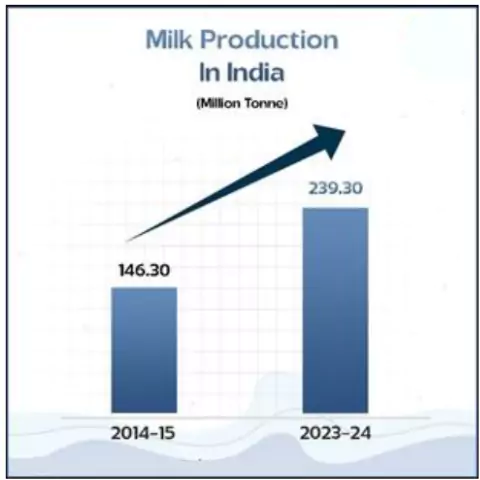
About India’s Dairy Sector
- Global Leadership in Production: India is the world’s largest milk producer, contributing nearly 25% of global supply, with milk output rising from 146.3 MT in 2014–15 to 239.3 MT in 2023–24.
- This reflects the country’s strong base of livestock resources and farmer-driven cooperatives.
- Per Capita Availability: The availability of milk for each person in India has risen sharply over the past decade.
- Per capita supply has gone up by 48%, with more than 471 grams/person a day in 2023–24. This is far above the world average of around 322 grams/person a day.
- Economic Backbone: The dairy sector contributes 5% to national GDP, making it the largest agricultural product.
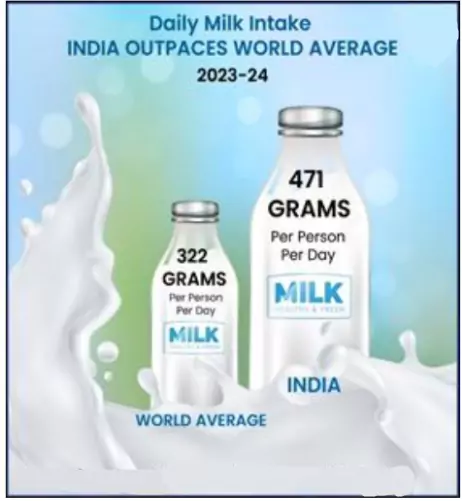 It sustains over 8 crore farmers, many of them small and marginal, functioning as a critical livelihood source.
It sustains over 8 crore farmers, many of them small and marginal, functioning as a critical livelihood source.
- Strength of the Cooperative Dairy Network: The cooperative dairy sector in India is extensive and well organised.
- As of 2025, It includes 22 milk federations, 241 district cooperative unions, 28 marketing dairies and 25 Milk Producer Organisations (MPOs). Together, they cover about 2.35 lakh villages and have 1.72 crore dairy farmers as members.
- Women-Centric Enterprise: Nearly 70% of the dairy workforce are women, and more than 48,000 women-led cooperatives operate at the village level, positioning dairy as a true driver of inclusive growth and empowerment.
- The all-women Shreeja Milk Producer Organisation received the prestigious Dairy Innovation Award from the International Dairy Federation at the World Dairy Summit in Chicago for its pioneering work in empowering women.
Growth in Bovine Population
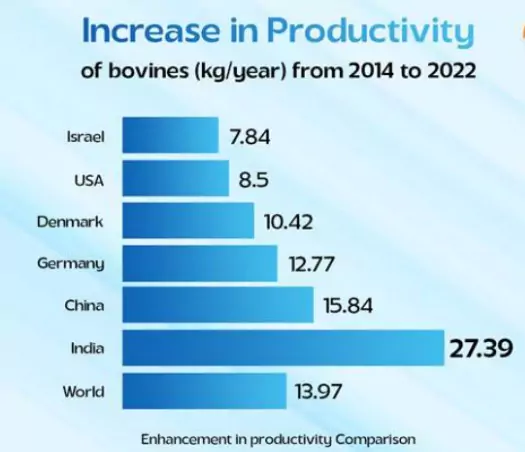
- India has a vast bovine population of 303.76 million (cattle, buffalo, mithun, yak), forming the backbone of both dairy production and drought power in agriculture.
- In addition, 74.26 million sheep and 148.88 million goats contribute significantly, especially in arid and semi-arid regions.
- Between 2014 and 2022, India recorded a 27.39% growth in bovine productivity (Kg/year) – the highest in the world, surpassing countries like China, Germany, and Denmark, and far exceeding the global average growth of 13.97%.
- Role of Government Schemes in Productivity Growth: This progress stems from programmes like the Rashtriya Gokul Mission (RGM), which focuses on bovine breeding, genetic upgradation, and breed productivity enhancement.
- The Livestock Health Disease Control Programme (LHDCP) has expanded healthcare access through Mobile Veterinary Units (MVUs) that provide disease diagnosis, vaccination, treatment, minor surgeries, and extension services directly at farmers’ doorsteps.
- Integration of Traditional and Modern Practices: In addition, Ayurveda is being integrated with modern veterinary practices to promote sustainable livestock health.
- Ethno-Veterinary Medicine (EVM) is emerging as a cost-effective, eco-friendly alternative to combat antibiotic resistance. Its successful use in treating bovine mastitis demonstrates potential to reduce dependence on synthetic drugs and build healthier, more resilient dairy systems.
|
Journey of India’s Dairy Revolution & Key Initiatives
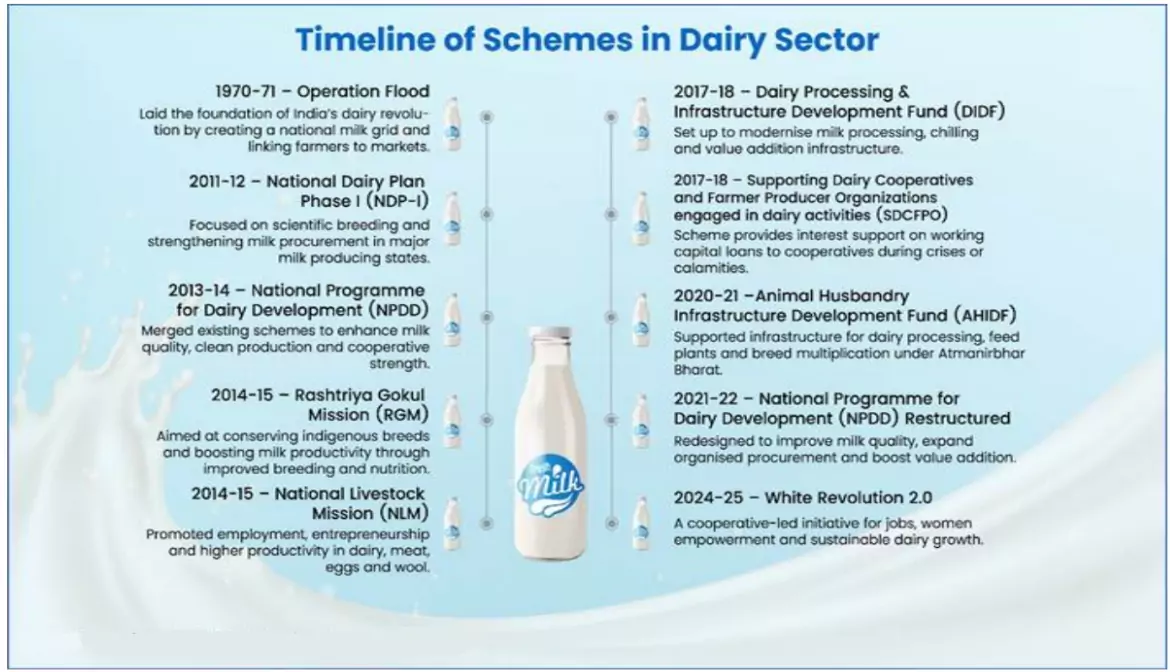
- Establishment of NDDB (1965): The National Dairy Development Board (NDDB) was set up in Anand, Gujarat to replicate the Amul cooperative model of organizing farmers into producer unions.
 This laid the foundation for a farmer-centric, cooperative-led dairy ecosystem in India.
This laid the foundation for a farmer-centric, cooperative-led dairy ecosystem in India.
- Operation Flood – The Dairy Revolution (1970): Launched in 1970 under Verghese Kurien, Operation Flood created Anand-pattern cooperatives nationwide, linking rural producers with urban consumers.
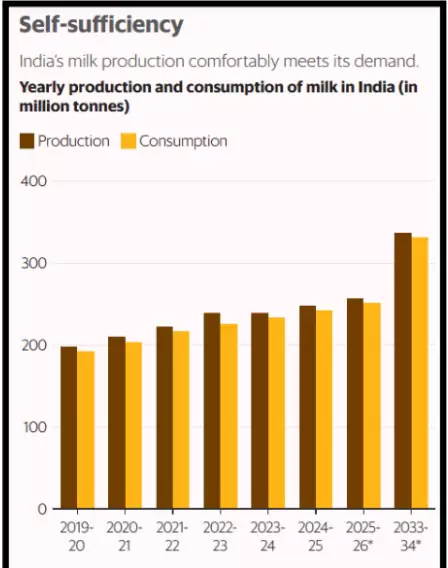 This turned India from a milk-deficient nation into the largest milk producer globally, and NDDB was later declared an Institution of National Importance (1987).
This turned India from a milk-deficient nation into the largest milk producer globally, and NDDB was later declared an Institution of National Importance (1987).
- Rashtriya Gokul Mission (RGM): Initiated in 2014 and revised in 2025 with a ₹3,400 crore outlay, RGM focuses on indigenous breed conservation, bovine genetic upgradation, and productivity enhancement.
- It expands the artificial insemination (AI) network, strengthens semen stations, and promotes sex-sorted semen and bull production. With its implementation, milk production increased by 63.56% and productivity by 26.34% in the last decade.
- Artificial Insemination & National Artificial Insemination Programme (NAIP): Currently, 33% of breedable bovines are covered through AI, while the rest depend on scrub bulls.
- Under the NAIP, free AI services are delivered at farmers’ doorsteps. By August 2025, NAIP had covered 9.16 crore animals and performed 14.12 crore inseminations, benefitting 5.54 crore farmers.
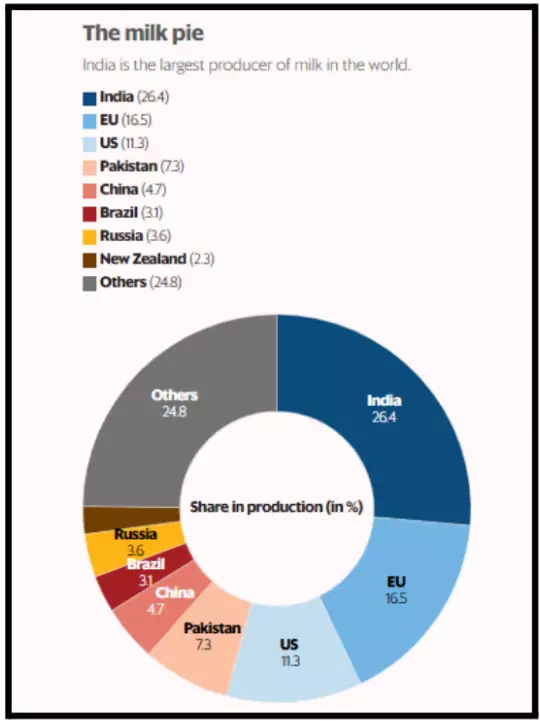 Advanced Reproductive Technologies: To further boost productivity, 22 IVF labs have been established, and over 10.32 million doses of sex-sorted semen have been produced, with 70 lakh doses already used.
Advanced Reproductive Technologies: To further boost productivity, 22 IVF labs have been established, and over 10.32 million doses of sex-sorted semen have been produced, with 70 lakh doses already used.
- These interventions ensure more female calves and long-term growth in milk supply.
- MAITRI Technicians: The Multipurpose AI Technicians in Rural India (MAITRI) scheme trains rural youth for three months and provides financial support for veterinary equipment.
- Over 38,700 MAITRIs are currently providing doorstep breeding and veterinary services, ensuring last-mile access to scientific livestock management.
- Progeny Testing & Breed Multiplication: Since milk is a sex-limited trait, progeny testing helps in selecting high-quality bulls based on the performance of their daughters.
- Between 2021–24, 3,747 progeny-tested bulls were produced, and 132 breed multiplication farms sanctioned, improving access to quality animals.
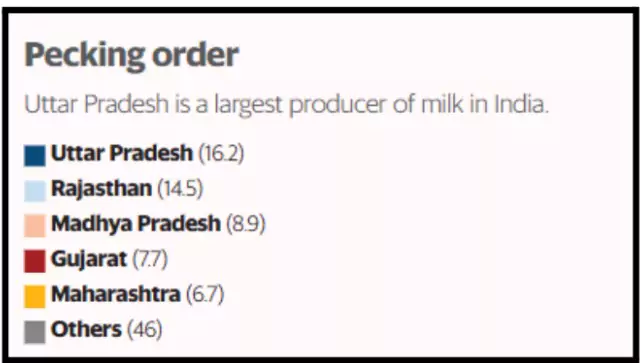 NDDB Dairy Services & MPOs: NDDB has supported 23 Milk Producer Organisations (MPOs), including 16 women-run MPOs, which collectively empower 1.2 million producers across 35,000 villages.
NDDB Dairy Services & MPOs: NDDB has supported 23 Milk Producer Organisations (MPOs), including 16 women-run MPOs, which collectively empower 1.2 million producers across 35,000 villages. -
- These MPOs strengthen the inclusive growth model of India’s dairy sector.
- White Revolution 2.0 (2024–29): A new five-year plan to scale up cooperatives, with targets to form 75,000 new dairy cooperatives and strengthen 46,422 existing ones.
- By 2028–29, milk procurement by cooperatives is expected to reach 1007 lakh kg/day.
- It also integrates sustainability and circularity, through cooperatives engaged in biogas production, organic manure, and natural farming practices, while managing hides, bones, and horns of fallen animals for waste-to-value utilization.
Significance of Dairy Sector in India
- Nutritional Security: Milk is a near-complete food, vital for addressing malnutrition and hidden hunger, and supports schemes like Mid-Day Meal and Integrated Child Development Services (ICDS).
- Dairy supply in these nutrition programmes ensures protein and micronutrient intake among children and women.
- Daily Rural Income: Unlike seasonal crops, dairy provides daily income flow, cushioning farmers from climate and market shocks.
- Employment Generation: The sector creates extensive direct and indirect jobs across production, processing, logistics, and marketing.
- It serves as a poverty alleviation tool, providing steady cash flow to landless and marginal farmers, protecting them from seasonal crop shocks.
- Export Potential: With value addition (cheese, probiotics, infant formula), dairy can boost foreign exchange earnings and global competitiveness.
- However, India faces WTO trade barriers, SPS standards, and branding challenges, requiring policy reforms to tap global markets effectively.
Challenges to India’s Dairy Sector
- Low Productivity: Despite a large bovine population, India’s average milk yield is far lower than global leaders like Israel and New Zealand, limiting efficiency.
- This is due to a fragmented smallholder model, lower genetic potential of indigenous breeds, and inadequate nutrition and healthcare.
- Inadequate Infrastructure: A lack of chilling plants, cold chains, and processing units leads to milk spoilage and reduced nutritional quality, particularly in rural areas.
- Only 20–22% of India’s milk is processed in the formal sector (vs. >90% in EU/US), reflecting a weak value chain.
- Fodder Shortages: India suffers from a 12–15% green fodder deficit and a 25% dry fodder deficit, which lowers productivity and pushes up costs.
- Silage making, hydroponic fodder, and dual-purpose crops are underutilised solutions.
- Regional Disparities: Strong cooperatives in Gujarat, Maharashtra, and Karnataka contrast with weaker structures in eastern and north-eastern states, creating uneven growth.
- Disease Burden: Outbreaks like Foot-and-Mouth Disease (FMD) and Lumpy Skin Disease significantly reduce livestock productivity and increase farmer losses.
- Climate Vulnerabilities: Enteric fermentation from cattle accounts for ~55% of India’s agricultural GHG emissions. Rising heat stress, water scarcity, and extreme weather worsen sustainability challenges.
- Market Volatility: Increasing input costs (fodder, feed, healthcare) and global price fluctuations affect farmer incomes and market stability.
- Governance & Institutional Issues: Overlapping agencies such as the National Dairy Development Board (NDDB), Department of Animal Husbandry and Dairying (DAHD), Food Safety and Standards Authority of India (FSSAI), and various cooperatives create fragmentation in policy implementation.
- Milk Adulteration (Integrity at Stake): Adulteration scandals, particularly in the unorganised sector, are not just technical failures but ethical breaches. They compromise consumer health, food safety, and trust, undermining the very purpose of dairying as a source of nutrition.
Global Initiatives and Partnerships for Sustainable and Innovative Dairy Development:
- UN FAO & UNEP Dairy Programmes: Promote sustainable livestock practices, low-carbon dairying, and nutritional security.
- Global Dairy Platform (GDP): Encourages nutrition advocacy, climate-smart dairying, and innovation partnerships.
- International Dairy Federation (IDF): Sets global dairy standards, promotes research collaboration, and recognises innovations like India’s Shreeja MPO.
Global Best Practices in Sustainable and Technology-Driven Dairy Systems:
- European Union – Sustainability Incentives: EU’s Common Agricultural Policy (CAP) ties subsidies to sustainable dairy, traceability, and reduced carbon intensity.
- New Zealand – Fonterra Model: Farmer-owned Fonterra cooperative integrates producers into global value chains, with emphasis on climate-smart pasture management.
- Israel – Precision Productivity: Achieves ~12,000 liters/cow/year using ICT-enabled monitoring, scientific feeding, and selective breeding.
- United States – Technology-Driven Dairy: Employs automated milking systems, IoT-based cattle health monitoring, and genetic improvement programmes.
- Netherlands & Denmark – Cold Chain Leadership: Integrated farm-to-consumer cold chains and digital logistics systems ensure high-quality, traceable milk.
- Kenya & East Africa – Community Cooling Centres: Solar-powered chilling centres and cooperative-based models reduce milk spoilage and empower smallholder farmers.
- India can replicate such community-level cooling centres to cut rural milk losses.
|
Constitutional and Sustainable Development Frameworks Linking Dairy to Nutrition, Equity, and Climate
- Article 47 – Nutrition Duty: Directs the State to raise the level of nutrition and public health, directly linked to milk’s nutritional role.
- Article 39(b) – Equitable Distribution: Calls for fair distribution of resources like milk and livestock assets to serve the common good.
- Article 51A(g) – Fundamental Duty: Imposes a duty on citizens to protect the environment, relevant for sustainable dairying.
- SDG 2 (Zero Hunger): Dairy contributes to ending hunger and malnutrition.
- SDG 5 (Gender Equality): Women-led cooperatives strengthen gender inclusivity and empowerment.
- SDG 12 (Responsible Consumption): Efficient milk handling and reduced wastage promote sustainable food systems.
- SDG 13 (Climate Action): Climate-smart dairy reduces methane emissions and builds resilient systems.
Way Forward
- Genetic Improvement & Productivity: Increase Artificial Insemination (AI) coverage from 33% to 70%, expand IVF labs and sex-sorted semen, and promote indigenous breeds to enhance bovine productivity.
- Infrastructure Development: Strengthen chilling plants, cold chains, processing hubs, and fodder systems under PMKSY and Agri Infrastructure Fund (AIF) to reduce post-harvest losses and support exports.
- Women-Centric & Inclusive Models: Empower Self-Help Groups (SHGs), Milk Producer Organisations (MPOs), and women-led cooperatives for steady incomes and inclusive rural growth.
- Climate-Smart & Sustainable Practices: Promote fodder diversification, water-efficient crops, biogas plants, and circular economy models to ensure environmental sustainability.
- Digital Modernisation: Deploy IoT for cattle health, blockchain for milk traceability, and AI for disease forecasting to improve efficiency, transparency, and farm-level management.
- Regional & Global Competitiveness: Strengthen dairy cooperatives in eastern and north-eastern India to reduce regional disparities, and diversify into cheese, probiotics, infant milk powder, and organic dairy exports for global market leadership.
- Research, Innovation & Partnerships: Invest in vaccine R&D, feed technology, animal genetics via ICAR-NDRI, NDDB, and veterinary universities, and leverage Public–Private Partnerships (PPP) and dairy diplomacy to scale technology, branding, and South–South cooperation.
- Curbing Adulteration (Integrity in Nutrition): Strengthen FSSAI regulation, mobile testing units, and digital monitoring at the village level. Enforcing zero tolerance for adulteration is not only a technical need but an ethical duty—to protect public health, consumer trust, and the right to safe food.
Conclusion
India’s dairy sector reflects nutrition, livelihoods, and empowerment, aligned with Articles 47 and 39(b). From Operation Flood to White Revolution 2.0, farmer cooperatives, women’s participation, and scientific innovation can transform rural economies into a sustainable, inclusive, and globally competitive food system.
- “As Dr. Verghese Kurien said, “Dairy is a way of life, not just a business,” underscoring its central role in food security, rural development, and social equity.”
Read More About: Revised National Program for Dairy Development (NPDD)
Read More About: Bridge the Milk Divide For a Nutritionally Secure India
![]() 30 Sep 2025
30 Sep 2025


 It sustains over 8 crore farmers, many of them small and marginal, functioning as a critical livelihood source.
It sustains over 8 crore farmers, many of them small and marginal, functioning as a critical livelihood source.
 This laid the foundation for a farmer-centric, cooperative-led dairy ecosystem in India.
This laid the foundation for a farmer-centric, cooperative-led dairy ecosystem in India. This turned India from a milk-deficient nation into the largest milk producer globally, and NDDB was later declared an Institution of National Importance (1987).
This turned India from a milk-deficient nation into the largest milk producer globally, and NDDB was later declared an Institution of National Importance (1987). Advanced Reproductive Technologies: To further boost productivity, 22 IVF labs have been established, and over 10.32 million doses of sex-sorted semen have been produced, with 70 lakh doses already used.
Advanced Reproductive Technologies: To further boost productivity, 22 IVF labs have been established, and over 10.32 million doses of sex-sorted semen have been produced, with 70 lakh doses already used.
 NDDB Dairy Services & MPOs: NDDB has supported 23 Milk Producer Organisations (MPOs), including 16 women-run MPOs, which collectively empower 1.2 million producers across 35,000 villages.
NDDB Dairy Services & MPOs: NDDB has supported 23 Milk Producer Organisations (MPOs), including 16 women-run MPOs, which collectively empower 1.2 million producers across 35,000 villages. 